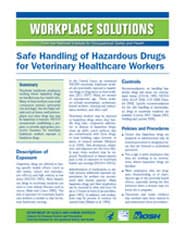Veterinary Safety & Health: Chemical Safety
Chemical Safety
Veterinary medicine and animal care workers are at risk of exposure to many different chemical hazards including glutaraldehyde and other disinfectants, hazardous drugs, latex, pesticides, and waste anesthetic gases. Exposure to these chemicals may occur by dermal contact (touching the skin) and/or inhalation (being breathed in). Splashes may result in chemical contact with the skin, eyes, or mucous membranes.
Overview of Chemical Safety
NIOSH: Chemical Safety in the Workplace
NIOSH Indoor Environmental Quality: Chemicals and Odors
NIOSH Pocket Guide to Chemical Hazards
OSHA Hazard Communication Standard

American Association of Poison Control Centers
Ammonia
Carbon Monoxide
Cleaning Chemicals
- Follow manufacturer’s instructions and all product label precautions.
- Do not mix different cleaning products; some mixtures produce toxic gases.
OSHA/NIOSH InfoSheet: Protecting Workers Who Use Cleaning Chemicals
OSHA/NIOSH Poster: Protect Yourself: Cleaning Chemicals and Your Health
Disinfectants
CDC Guideline for Disinfection and Sterilization in Healthcare Facilities, 2008
Iowa State University Center for Food Security and Public Health: Disinfection
Some examples:
- Ethylene oxide NIOSH Ethylene Oxide
- Glutaralde hyde NIOSH Glutaraldehyde NIOSH Glutaraldehyde: Occupational Hazards in Hospitals DHHS (NIOSH) Publication No. 2001-115
- Formaldehyde NIOSH Formaldehyde
- Peracetic acid CDC Disinfection and Sterilization Guideline: Peracetic Acid Sterilization
Hazardous Drugs
Some examples:
- Antineoplastic and other hazardous drug exposures may occur when treating animals for cancer and other diseases.
- Hormones may be a reproductive hazard to female veterinarians.
- Follow product labels for handling restrictions and proper precautions.
- Micotil 300®, an injectable macrolide antibiotic, may cause illness or death in people who are exposed through needlestick injuries, skin cuts, puncture wounds, or contact with skin or mucous membranes.
- Chloramphenicol is banned for large animal use due to the risk of aplastic anemia in humans but is still used in small animals.
NIOSH Hazardous Drug Exposures in Healthcare
NIOSH Workplace Solution: Safe Handling of Hazardous Drugs for Veterinary Health Care Workers
DHHS (NIOSH) Publication No. 2010-150 (2010)
En Español
NIOSH Personal Protective Equipment for Health Care Workers Who Work with Hazardous Drugs
DHHS (NIOSH) Publication No. 2009-106 (2008)
NIOSH Workplace Solutions: Preventing Worker Deaths and Injuries When Handling Micotil 300®
DHHS (NIOSH) Publication No. 2007-124 (2007)
Hydrogen Sulfide
NIOSH ALERT: Preventing Deaths of Farm Workers in Manure Pits
Laboratories
OSHA Safety and Health Topic: Laboratories
Latex
NIOSH Occupational Latex Allergies
NIOSH Latex Allergy: A Prevention Guide
OSHA Laboratory Safety Latex Allergy
Micotil 300®
Mictotil 300® is a prescription injectable antibiotic used to treat respiratory disease in cattle and sheep.
FDA Animal Drug Safety Communication: Micotil 300 User Safety Alert; September 2017
NIOSH Workplace Solutions: Preventing Worker Deaths and Injuries When Handling Micotil 300 (2007)
NIOSH FACE Report: Cattle Rancher Hospitalized After Accidental Injection of Micotil (2005)
NIOSH FACE Report: Cattleman Dies Due to Accidental Injection (2003)
Personal Protective Equipment (PPE)
NIOSH Workplace Solution: Safe Handling of Hazardous Drugs for Veterinary Health Care Workers
DHHS (NIOSH) Publication No. 2010-150 (2010)
En Español
NIOSH Personal Protective Equipment for Health Care Workers Who Work with Hazardous Drugs DHHS (NIOSH) Publication No. 2009-106 (2008)
NIOSH [2005]. NIOSH respirator selection logic 2004 DHHS (NIOSH) Publication No. 2005–100.
Pesticides
Pesticide exposures to workers may occur:
- when treating animals for fleas, ticks, or mites.
- when working with animals who have been treated with pesticides.
National Pesticide Information Center
Phosphine gas
Phosphine gas exposures to workers may occur when treating:
- animals that have ingested rodenticides containing zinc phosphide
- animals that have ingested insecticides containing aluminum phosphide
AVMA Phosphine product precautions
Waste anesthetic gases
Exposure to nitrous oxide, halothane, isoflurane and other waste anesthetic gases may occur during veterinary dentistry and surgical procedures.
American College of Veterinary Anesthesiologists: Control of Waste Anesthetic Gases in the Workplace
OSHA Safety and Health Topic: Waste Anesthetic Gases
NIOSH Waste Anesthetic Gases: Occupational Hazards in Hospitals
DHHS (NIOSH) Publication No. 2007-151 (September 2007)
En Español
Waste Disposal
AVMA Waste Disposal by Veterinary Practices: What Goes Where?
